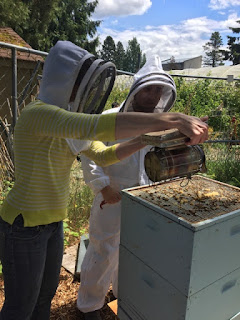EdCC keeps two bee hives in its northwest garden area. I had the opportunity to suit up and visit them last week and it was a fun and learning experience. First fun fact I learned is that bee suits aren't actually bee proof, they are bee resistant, so don't go in with too much false confidence if you go visit them. Next its that bee's don't like meat, so the next time a yellow and black insect lands on your food at a picnic it will most likely be a carnivorous wasp and not a bee. They eat bees too so they aren't friends.
There are two species of bees at EdCC, one is Italian and they are both being a bit slow in their build out of their honey comb, pollen gathering, and territory exploration according to their main keepers. The hives were newly started this winter and our professor, Gwen, has been recruited to help them develop into successful productive hives that can supply the culinary school with lots of locally produced honey.

This is one of the two bee hive huts located in the college's gardens. The bee's are building from the bottom most section up with their honey comb and the main entrance is the dark slit seen at the bottom.

A bee honey comb layer in the hive, this one is not built out very much at all and will hopefully receive more attention later in the summer when the top layer of the hive is developed.

This grate keeps the queen bee lower in the hive to build up the lower levels first. She is slightly larger in girth than the other bee casts and while they are free to move up and down the hive, she is restricted for now.

Bee Larva in the honey comb

The yellow objects attached to the bee's legs are the pollen from flowers nearby

A more built out section of honey comb with worker bees tending to it


This was a really interesting behavior to observe, the bees are chaining together to measure distance between the honey combs. They can keep uniform space between the combs using this method.
The queen been with her larger and longer abdomen. She is mobile and can fly, but generally stays in the hive busy with lots of work.

Bee suit protection. Remember to fully zip up your head piece
The experience was a lot of fun and interesting to see how busy the hives are. I recommend it for anyone who has never been up close to a bee hive to go and see it. The hive functions as a team and there is a lot of interesting literature and documentaries out there about their interactions.
For quick general read on bee hives: http://www.bbka.org.uk/learn/general_information/life_in_the_hive
No one was stung on my trip so any students that follow please keep the standard.
































